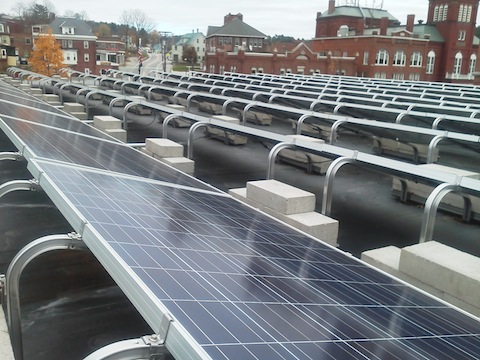William Hardy, Jr. from Newport (NH) Fire sent in these photos of something we will probably all begin to see more of in the near future. Take a look from the street and think about what you see…


With any moderate smoke this would totally be concealed…


The installation of PhotoVoltaic Modules (PV Modules) is becoming common place everywhere. If you are not aware of these in your first due it’s for one of two reasons:
1.) They are currently being installed (or will be in the VERY near future)
2.) You just haven’t found them yet!
We featured a supplemental page awhile ago with some additional information on PV Modules and their characteristics. Click Here for that info and take a moment to think about trying to vent that roof. Keep in mind, you can’t always see them from the street.

Google or Bing Maps (using satellite view) are great websites to scan for PV panels on roof tops. I’ve scanned my area multiple times for something unrelated, only to notice an array of panels covering a roof top.
Keep in mind that neither service updates frequently and your area may be dated.
These solar panels are being installed on Kohls department stores across the nation. The representatives of the company gave us all of the information on how to shut down power to the panels and in general what to be cautious of.
Not only will this make roof venting difficult (to say the least) these panels are “electrified” if the sun is out. The panels are wired in series and in some commercial, or even residential applications you could be talking some deadly amperage. If you see this it may be best to go to vent plan B. By the way you can shut down power from the panels but if the sun is out the only way to keep the panel from producing power is to cover it. Again, best to stay away from them if the sun is out.
I used to work at a renewable energy company a couple years back… I learned a few useful things about these systems. With a grid tie system, you will have high voltage on the roof. You will either have an AC trunk cable that runs to each solar panel (in the case of Enphase or similar micro inverters) from the building’s electrical service, or you will have a high voltage DC circuit coming down from the panels. This may run up to 600 volts DC and can generate some pretty angry current.
Off grid systems or grid-interactive with battery backup are different. Voltages may be lower on the roof (though the recent high voltage charge controllers available from Schneider Electric and Morningstar have changed the game – again, up to 600V). In those systems there will be combiner boxes on the roof and you can actually just turn off breakers to stop the power flowing down into the structure. With these, there will be LARGE storage battery banks within the building that can present the usual explosion/nasty sulfuric acid risks!!
Your best bet I’d say would be to stay away from the panels. When I left working in the renewable energy field, there were just starting to be some products on the market that’d allow remote shutoff of the high voltage circuit from the roof, but these were in their infancy…
On a grid tie system, as soon as you turn off the AC power to the structure or shut off the grid tie inverter, it will stop providing AC power. This will not shut off the high voltage DC circuit. Avoid the panels and their wiring! Seriously. Also keep in mind that even if the fancy new systems where every panel has a shutoff device on it come out and become mandatory…. you will still have the old ones in place and operational on buildings up to 20 years from now. Owners of PV systems tend to hang onto them until the juice just ceases to flow.
Oh, I should add, the arcs that can be produced by PV system wiring are hilariously bad. I used to sometimes take an old 200 watt or so panel out back and play with drawing as big and angry a hot, hissing spark as I could manage out of the leads with it in full sun…. at times I could get *self-extinguishing* wire insulation to just vaporize and burn away in midair from the extreme heat. 🙂